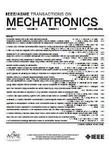Journal
Please choose volume & issue:
-
Hybrid Soft Actuator With Metamaterial-Inspired Skeleton for Adjusting Mechanical Properties: Design, Modeling, and Experiments
Keywords:SkeletonActuatorsMechanical factorsMathematical modelsDeformationSoft roboticsMetamaterialsMechanical PropertiesSoft ActuatorsLinear RangeSoft RobotsSoft SystemLateral StiffnessHigh PressureYoung’s ModulusAtmospheric PressureMaximum ForceRotation AngleDexterityControl UnitChanges In ForceExternal LoadStrain EnergySilicone RubberBucklingAxial ForceLateral ForceForce VariabilityBending MotionAxial PressureApplication Of PressureThermoplastic PolyurethaneUnstructured EnvironmentsUse Of CapabilitiesSoft GripperGeometric ParametersAdjusting mechanical propertyhybrid fiber reinforced actuator (HFRA)metamaterial inspired skeletonsoft wrist-gripperAbstracts:Soft robots have demonstrated significant potential in numerous fields due to their inherent compliance; however, the soft nature of their actuators poses challenges for applications requiring load-carrying capacity, and their mechanical properties are nonadjustable postfabrication. Drawing inspiration from the mechanical programmability of metamaterials, we propose a new hybrid fiber-reinforced actuator (HFRA) by incorporating a metamaterial-inspired skeleton into the fiber-reinforced actuator (FRA). By utilizing the V-beam unit, the skeleton maintains the same deformation tendency as the FRA while allowing for adjustable mechanical properties through programming its thickness. Experimental results indicate that this skeleton not only transforms the nonlinear force–displacement relationship of the FRA into linearity and adjusts its linear range of force–pressure characteristics, but also enhances both axial and lateral stiffness of the HFRA. To demonstrate these capabilities, we fabricate a soft wrist-gripper system employing our HFRA technology, showcasing omnidirectional elongation and bending capabilities of the wrist along with versatile grasping and manipulation abilities across various object orientations. We believe that integrating metamaterials with soft robots could establish a new paradigm for designing, actuating, and enhancing functionality in next-generation soft robots.
-
Finite-Time Convergent and Weight-Unbalanced $k$WTA Network With Multirobot Competitive Coordination
Keywords:Multi-robot systemsTopologyConvergenceNetwork topologyReal-time systemsVectorsRobot kinematicsNetwork ConvergenceFinite-time ConvergenceUndirectedMulti-agent SystemsConvergence TimeCommunication TopologyNeural NetworkNumerical SimulationsAccuracy Of ModelTheoretical AnalysisMulti-agentLagrange MultiplierEquilibrium PointInequality ConstraintsGraph TheoryError FunctionFinite TimeDirected GraphInput StateQuadratic ProgrammingQuadratic Programming ProblemDynamic InputDynamic TrackingParameter ConvergenceFinite-time Control $k$ -winner-take-all ( $k$ WTA)competitive coordinationfinite-time convergencemultirobot systemweight-unbalanced topologyAbstracts:A weight-unbalanced $k$-winner-take-all (WU-$k$WTA) network with finite-time convergence is constructed, analyzed, and applied to undirected and directed multirobot systems with unbalanced weights of communication topology. The convergent time of the finite-time $k$WTA network is theoretically derived with theorems proof. Furthermore, comparisons are conducted among the proposed WU-$k$WTA network and other existing $k$WTA works, and results reveal that the proposed network has high precision when encountering undirected or directed weight-unbalanced topologies. Additionally, a dynamic target tracking algorithm is established by employing the proposed WU-$k$WTA network, and its feasibility and efficiency are validated via simulations on a multirobot system and an experiment on the E-puck robot physical platform.
-
A Robotic Transtibial Prosthesis With Equilibrium-Adjustable Parallel Springs to Improve Energy Efficiency in Slope Walking
Keywords:SpringsAnkleProstheticsTorqueMotorsLegged locomotionCostsEnergy EfficiencyParallel SpringSlope WalkingEnergy ConsumptionTheoretical AnalysisAmputationMetabolic CostPeak TorqueSlope ConditionsExperimental GroupWalking SpeedState MachineConsumption CostStrain GaugesNet EnergyHuman CostsSlope AngleSwing PhaseElasticity CoefficientHydraulic SystemMetabolic ExpenditurePassive PhaseEnergy Consumption CostLevel GroundLowest Energy ConsumptionHeel StrikeAnkle AngleSpring SystemMotor TorqueMetabolic Energy ExpenditureEnergy consumptionequilibrium-adjustable parallel springs (EAPSs)metabolic costrobotic transtibial prosthesisslope walkingAbstracts:Energy efficiency is crucial in developing transtibial prostheses, encompassing two main aspects: amputee metabolic cost and prosthetic energy consumption. The parallel elastic structure is commonly used to enhance power efficiency, but usually with a fixed balanced angle. However, it can be demonstrated that the energy efficiencies in both aspects are related to this balanced angle when walking on different slopes. Therefore, we developed a powered transtibial prosthesis with adjustable parallel springs to change the equilibrium position. Slope adaptation strategies in both aspects are proposed based on theoretical and dataset analysis. The effectiveness is experimentally illustrated through multiple unilateral transtibial amputees walking on various slopes. The results demonstrate that the proposed prosthesis can effectively increase the peak torque, and substantially impact the energy consumption and the metabolic cost by adjusting the equilibrium position. We also confirm that the optimal positions in the metabolic cost and the prosthetic energy consumption are different in the same slope condition.
-
Distributed Collaboration in Multimanipulator Systems With Switching and Weight-Unbalanced Topologies
Keywords:CollaborationTopologyManipulatorsSwitchesHeuristic algorithmsManipulator dynamicsTask analysisSwitching TopologiesPerformance IndicatorsInequality ConstraintsNeural ControlPower OutagesPhysical ExperimentsNeural DynamicsJoint VelocityLeft EigenvectorsLagrange MultiplierDiagonal ElementsGraph TheorySpace ExplorationNodes In The GraphEquality ConstraintsJoint AnglesQuadratic ProgrammingLaplacian MatrixConvergence TimeDistributed MannerQuadratic Programming ProblemFish LineagesNormal ConeCentral CommandDerivation Of FormulaDistributed collaborationmultimanipulator systems (M $^{2}$ Ss)neural dynamicsswitching topologyweight-unbalanced topologyAbstracts:In multimanipulator systems (M$^{2}$Ss), one of the main challenges for the collaboration of manipulators is posed by the switching and weight-unbalanced topologies (SWUTs) due to the different communication power and unpredictable connection failures, which has not been investigated and can cause instability and performance degradation. In this article, following the distributed principle, the collaboration in M$^{2}$Ss with SWUTs is constructed for problems in the forms of optimization with a universal convex performance index and an inequality constraint for joint velocities, in which an algorithm for weight-unbalanced topologies to estimate their required left eigenvector is introduced, and a distributed formula with topology switching compensation is proposed as well. In the next step, a neural dynamics controller is employed to solve the aforementioned optimization problems, with its stability and convergence proved strictly. Afterwards, the efficacy of the proposed controller is validated through both simulations and physical experiments, and comparisons are provided to demonstrate its superiority in handling the abovementioned challenges in the distributed collaboration in M$^{2}$Ss with SWUTs.
-
Performance Investigation and Improvement of a Two-DOF Inertial Piezoelectric Robotic Insertion Device for Capillary Micropuncture
Keywords:ShaftsForceRobotsPiezoelectric actuatorsFrictionNeedlesAcousticsCapillaryRobotic DevicesInertial DevicesHigh-resolutionBlood VesselsTheoretical AnalysisRobotic SystemRange Of ForcesLarge StrokeAdjustable RangeCoupling RatePositive PressureOuter DiameterTranslational MotionFriction ForceRotational MotionNeedle TipDirection Of RotationPower AmplifierLinear VelocityPiezoelectric ActuatorOutput DisplacementPiezoelectric CeramicsLinear GuideLinear DisplacementMaximum FrictionNewton’s Second LawCritical PressureSawtoothCoulomb FrictionCapillary micropunctureoutput force improvementpiezoelectric devicerobotic micromanipulation systemAbstracts:Insertion of capillaries poses a great challenge to biomedical researchers owing to the demanding requirements of multi-DOF, large stroke, high resolution, and adjustable force. In this article, the output performance of a two-DOF inertial piezoelectric robotic insertion device (PRID) was studied and improved, and its application potential in vascular micropuncture was verified. First, configuration and working principle of the PRID were elaborated. Next, theoretical analyses were conducted to obtain the adjustable pretightening force range, thereby guiding the improvement of the puncture force characteristics. Then, a series of experiments were carried out to study its output characteristics. Eventually, a robotic micromanipulation system was proposed, and the capillary micropuncture tests were implemented. The experimental results indicated that the PRID achieved linear and rotary strokes of 36 mm and 360°, the puncture force range was from 16.85 mN to 154.26 mN; the coupling rates in linear and rotary directions separately were 4.04% and 3.21%, the displacement resolutions in linear and rotary directions separately were 6.5 nm and 0.6 μrad, and the exciting frequency could be used to actively adjust the puncture force. Furthermore, the PRID successfully completed the micropuncture of two sizes of silicone capillaries on the eyeball model in collaboration with a six-DOF piezoelectric platform. The PRID can be applied in the field of micropuncture of cells and blood vessels with different shapes and sizes.
-
Free-Space Dynamic Modeling of an MRI-Actuated Robotic Catheter
Keywords:CathetersRobotsMathematical modelsDynamicsComputational modelingMagnetic resonance imagingActuatorsDynamic ModelRobotic CatheterMagnetic Resonance ImagingDifferential EquationsExperimental ValidationPartial Differential EquationsTheory StatesStatic Magnetic FieldLagrange EquationsPosition TrajectoryFlexible SegmentsRigid SegmentsSeries Of SegmentsShape Of SegmentTime StepYoung’s ModulusStep SizeState VariablesEntry PointLinear VelocityEnd Of SegmentDynamic Modeling ApproachPause TimeBody FrameBackward Euler MethodProximal SegmentSpatial FrameAngular VelocityCatheter TipDynamic modelingrobotic catheterAbstracts:In this article, we present the free-space dynamic modeling of a novel magnetic resonance imaging (MRI)-actuated robotic catheter. The MRI-actuated robotic catheter is modeled as a series of rigid and flexible segments, where the rigid segments are embedded with a set of current-carrying micro-coils. The robotic catheter is steered by controlling the currents passing through the actuators under the influence of the static magnetic field of the MRI-scanner. In this article, two discrete-time dynamic models of the MRI-actuated robotic catheter are presented and evaluated. The first model presented is a full-body Cosserat-rod-based dynamic model based on the dynamic Cosserat-rod theory, where the dynamic Cosserat-rod partial differential equations and the Euler–Lagrange equation are, respectively, used to derive the dynamic equations of the flexible segments and rigid segments. The second model presented is a hybrid Cosserat-rod-based dynamic model, where the dynamic equation of the rigid segments is derived using the Euler–Lagrange equation and the shape of the flexible segments is derived using the static Cosserat-rod theory. The proposed dynamic models are compared and experimentally validated using the 3-D positional trajectories collected from a catadioptric stereo tracking system.
-
Terrain Matching Algorithm Based on Trajectory Reconstruction and Correlation Analysis of Sliding Measurement Sequence
Keywords:TrajectoryTime measurementCorrelationParticle measurementsAtmospheric measurementsEstimationPosition measurementCorrelation AnalysisMatching AlgorithmTrajectory ReconstructionSingle MeasurementLocalization AccuracyPosition EstimationParticle FilterDirect TranslationSingle AlgorithmMatching AccuracyInertial NavigationMeasurement UpdateCandidate PointsCorrelation Analysis MethodFalse PeaksPosition Estimation AccuracyTrue PositiveSequence LengthUnimodalReal-time PerformancePosition ErrorMultibeam EchosounderAlgorithm In This ArticleSingle MatchUnderwater VehiclesFiltering AlgorithmTerrain MapMatching ErrorReference TrajectoryPosition MatchingCorrelation analysissliding measurement sequenceterrain matchingtrajectory reconstructionAbstracts:Single-point matching algorithm (point mass filter or particle filter) only uses the current time measurement to calculate the likelihood, which is prone to pseudopeak and false peak. In order to solve the problem, this article introduces the sequence correlation analysis into the single point matching algorithm, and uses the sliding measurement sequence to estimate recursively. First, a position sequence estimation method based on trajectory reconstruction is proposed, which calculates the new position sequence by the relationship between INS displacement and heading angle, instead of the direct translation of INS trajectory method in traditional algorithms. After that, the likelihood of the candidate point is calculated by the correlation analysis method using the corresponding sliding measurement sequence at the current time, and a more accurate position estimation is obtained after the measurement update. Simulation and experiments show that the position sequence obtained by the proposed method based on trajectory reconstruction is more accurate than that obtained by the direct translation inertial navigation method. Compared with only using single time measurement information, the likelihood calculation method based on correlation analysis of sliding measurement sequence can significantly reduce pseudopeak and false peak, and the positioning accuracy of terrain matching is improved.
-
Three-Dimensional Hybrid Thermal Model of SPMSM and Its Multiphysics Multiobjective Optimal Design
Keywords:Three-dimensional displaysOptimization modelsSolid modelingWindingsStator windingsPredictive modelsAir gapsMulti-objective OptimizationCross-sectionalComplex StructureTemperature DistributionGeneral Solution3D SpaceGlobal DistributionStructural BehaviorPredictive DistributionSynchronous MotorPermanent Magnet Synchronous MotorExperimental PrototypeMulti-objective ModelZ-axis DirectionMultiphysics ModelComplex ExchangesHousingHigh-dimensionalMaximum TemperatureDimensional SpaceTemperature PredictionEquatorial DomainInternal BoundaryStator TeethAir GapMotor TypeOutstanding PerformanceFast PredictionWide Range Of ResearchThermal PerformanceGlobal temperature distribution predictionmultiphysics multiobjective optimization designthree-dimensional hybrid thermal model (3D HTM)Abstracts:In this article, a three-dimensional hybrid thermal model (3D HTM) applied to the surface-mounted permanent magnet synchronous motor (SPMSM) is first presented. Starting from the x-y plane and the cross section along the z-axis direction of SPMSM, the thermal domain is subdivided, the general solution is derived, and the boundary condition is established. Next, the lumped parameter thermal network and the electromagnetic analytical model (EAM) based on the subdomain method are introduced to solve 3D HTM. The complex structure and heat exchange behavior of SPMSM in 3D space are fully accounted for. Meanwhile, the fast and precise prediction of the global temperature distribution of SPMSM is realized. Subsequently, in view of the excellent performance of 3D HTM, a multiphysics multiobjective optimization model applied to SPMSM is developed by combining EAM and the nondominated sorting genetic algorithm III (NSGA-III). The optimal design of SPMSM is accomplished quickly and efficiently. The multiphysics performance of SPMSM is significantly improved. Finally, the validity, accuracy, and practicality of this study are strongly demonstrated by the simulation computation and prototype experiment.
-
A Real-Time Self-Sensing Approach to Sensor Array Configuration Fusing Prior Knowledge for Reconfigurable Magnetic Tracking Systems
Keywords:MagnetometersSensor arraysFastenersRobot sensing systemsReal-time systemsPredictive modelsLocation awarenessTracking SystemSensor ArrayMagnetic TrackingMagnetic Tracking SystemWearableConvergence RateChanges In PositionAverage AccuracyLocalization AccuracyGlobal RateSevere DeformationAbdominal CircumferenceEnhancement Of StabilityGlobal ConvergenceDipole ModelIntestinalGastrointestinal TractMagnetic FieldObjective FunctionResults In FigHinge JointOptical Tracking SystemCoordinate FrameMagnetic FluxMagnetic PositionReal-time TrackingPermanent MagnetTracking PerformanceUpper RegionBasic ConfigurationFusing prior knowledgemagnetic trackingreconfigurable tracking systemsself-sensingwearable sensor arrayAbstracts:Wearable and reconfigurable magnetic tracking systems (MTSs) for tracking passive magnetic targets inside the body offer the benefit of closely conforming to the curvature of the human abdomen and accommodating individuals with different abdominal circumferences. However, the dynamic changes in sensor array configuration, known as deformation, caused by posture changes during long-duration examinations, impose significant challenges on MTSs that heavily rely on magnetometer poses. To address this, we propose a real-time self-sensing method based on the sensor array structural model and magnetic dipole model, which simultaneously estimates the magnet pose and the hinge angles on the sensor array. Experimental results demonstrate that our reconfigurable MTS achieves an average localization accuracy of 1.36$\,\pm\,$0.21 mm and 1.00$\,\pm\, 0.46^\circ$ even under severe deformation. Furthermore, we incorporate the prior knowledge about the sensor array configurations into the self-sensing algorithm. Theoretical analysis and experimental verification demonstrate that integrating prior knowledge can enhance algorithm performance, with a 28.57% enhancement in stability and up to a 6% improvement in global convergence rate.
-
Time-Synchronized Control for Spacecraft Reorientation With Time-Varying Constraints
Keywords:Space vehiclesQuaternionsVectorsSurface treatmentConvergenceAttitude controlSynchronizationTime-varying ConstraintsPositive ControlEnergy ConsumptionNumerical Simulation AnalysisSpacecraft AttitudeSliding Mode SurfaceSystem StateOptimal ControlUnit VectorAngular VelocityNormal VectorMoment Of InertiaControl ObjectiveTelescopeStates Of ElementsSign FunctionSliding Mode ControlObstacle AvoidanceTorque ControlInertial FrameUnit QuaternionArtificial Potential FieldFinite-time StabilityInertia MatrixSlide SurfaceBody FrameSliding Mode Control MethodTrajectory OptimizationLow Energy ConsumptionRunge KuttaAttitude constraintsattitude experimentsspacecraft reorientationtime-synchronization controlAbstracts:This article proposes a time-synchronized constrained controller to address the time-varying constrained reorientation problem in spacecraft attitude operations. The characteristics of time-varying attitude constraints are formulated and analyzed. The corresponding artificial potential field-based sliding mode surface is tailored for these constraints. This method utilizes the properties of time-synchronized stability to thoroughly contemplate the interrelationships among different state errors, enabling the synchronized convergence of individual error components while ensuring compliance with state constraints. This design leads to an increase in control efficiency compared with traditional sliding mode-based constrained attitude controllers without adding any computational burden. This efficiency is evident in terms of control energy consumption and convergence time. Theoretical analysis is presented to substantiate the rationality of the proposed method. To validate these advantages, the article conducts diverse numerical simulation analyses and designs corresponding hardware-in-the-loop (HiL) experiments to verify its practical deployment capabilities.
Hot Journals
- Risk Breakdown Matrix for Risk-Based Inspection of Transportation Infrastructure Projects
- Social Control in Outsourced Architectural and Engineering Design Consulting Projects: Behavioral Consequences and Motivational Mechanism
- 2022 Best Paper Award
- Hold-Ups and Failures in Negotiated Order: Unearthing the Nuances of Rework Causation in Construction
- Prevalence and Risk Factors for Poor Mental Health and Suicidal Ideation in the Nigerian Construction Industry
- CFRP–Cable-Stayed Bridge Hybrid with Partial Suspension and a Span Exceeding 3,000 m: Concept, Optimization, and Construction
- Impact of Wind Load Characteristics on Computed Bridge Stay-Cable Forces Used for Bridge Health Monitoring
- Weak-End and Frequency Detection of Elastically Supported Bridges by Contact Residual Response of Two-Axle Test Vehicle in a Round Trip
- Development of Performance-Based Fragility Curves of Coastal Bridges Subjected to Extreme Wave-Induced Loads
- An Analytical Model to Evaluate Short- and Long-Term Performances of Post-Tensioned Concrete Box-Girder Bridges Rehabilitated by an Ultrahigh-Performance Concrete Overlay
- Three-Dimensional Velocity Distribution in Straight Smooth Channels Modeled by Modified Log-Law
- Experimental Investigation on Flow Past Two and Three Side-by-Side Inclined Cylinders
- An Experimental Investigation of Rotor–Box Aerodynamic Interaction 1
- Modeling Gas–Liquid Flow Between Rotating and Nonrotating Annular Disks
- Entry Length Requirements for Two- and Three-Dimensional Laminar Couette–Poiseuille Flows
Advanced Materials (3,745)
- Structured Perovskite Light Absorbers for Efficient and Stable Photovoltaics
- Strategies for High‐Performance Solid‐State Triplet–Triplet‐Annihilation‐Based Photon Upconversion
- Atomic Engineering Catalyzed MnO2 Electrolysis Kinetics for a Hybrid Aqueous Battery with High Power and Energy Density
- Crystal Adaptronics: Global Performance Indices for Dynamic Crystals as Organic Thermal Actuators (Adv. Mater. 20/2020)
- Enlightening Materials with Photoswitches
Acta Astronautica (1,768)
- Mixed-integer trajectory optimization with no-fly zone constraints for a hypersonic vehicle
- Adaptive control design for active Pogo suppression of large strap-on liquid launch vehicles
- Machine learning based approach for modeling and forecasting of GPS–TEC during diverse solar phase periods
- Effect of two-dimensional micro-cavity surface on hypersonic boundary layer
- Investigation on burning behaviors of aluminum agglomerates in solid rocket motor with detailed combustion model








 User Center
User Center My Training Class
My Training Class Feedback
Feedback





